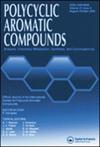1,2,3-三唑结合恶唑[5,4-d]嘧啶衍生物的合理设计与合成:体外细胞毒性和硅内分子对接模拟
IF 2.6
3区 化学
Q2 CHEMISTRY, ORGANIC
引用次数: 0
摘要
设计合成了一系列新的1,2,3-三唑类恶唑[5,4-d]嘧啶衍生物24a-j,并以依托泊苷为阳性对照,采用MTT还原法对MCF-7、A549、Colo-205和A2780细胞株进行了抗癌活性评价。化合物24a对MCF-7和A549细胞株的IC50值分别为0.11±0.086和0.13±0.094µM,化合物24h对MCF-7和A549细胞株的IC50值分别为0.18±0.071和0.33±0.067µM,具有较强的抗癌活性。这些活性比标准药物依托泊苷活性更有效。因此,这两种衍生物可用于癌症化疗的进一步研究。这一抗癌数据也得到了强效衍生物24a和24h的对接评分的支持。化合物24a和24h与人拓扑异构酶i β蛋白表现出分子相互作用,结合能分别为- 5.7和- 5.8 kcal/mol。本文章由计算机程序翻译,如有差异,请以英文原文为准。
Rational Design and Synthesis of 1,2,3-Triazole Incorporated Oxazolo[5,4-d] Pyrimidine Derivatives: In-Vitro Cytotoxicity and In-Silico Molecular Docking Simulations
A new series of 1,2,3-Triazole incorporated oxazolo[5,4-d]pyrimidine derivatives 24a-j were designed, synthesized and evaluated for their anticancer activity against MCF-7, A549, Colo-205, & A2780 cell lines by using MTT reduction protocol with Etoposide as positive control. Among the screened derivatives, the compound 24a showed potent anticancer activities against MCF-7, and A549 cell lines with IC50 values of 0.11 ± 0.086 and 0.13 ± 0.094 µM, whereas another compound 24h also showed potent anticancer activities against MCF-7, and A549 cell lines with IC50 values of 0.18 ± 0.071 and 0.33 ± 0.067 µM. These activities are more potent than standard drug, Etoposide activities. Hence, these two derivatives are allowed for further investigations in cancer chemotherapy. This anticancer data also supported by the docking score of both the potent derivatives, 24a and 24h. The compounds 24a and 24h showed molecular interactions with human topoisomerase IIβ protein and having binding energies are −5.7 and −5.8 kcal/mole, respectively.
求助全文
通过发布文献求助,成功后即可免费获取论文全文。
去求助
来源期刊

Polycyclic Aromatic Compounds
化学-有机化学
CiteScore
3.70
自引率
20.80%
发文量
412
审稿时长
3 months
期刊介绍:
The purpose of Polycyclic Aromatic Compounds is to provide an international and interdisciplinary forum for all aspects of research related to polycyclic aromatic compounds (PAC). Topics range from fundamental research in chemistry (including synthetic and theoretical chemistry) and physics (including astrophysics), as well as thermodynamics, spectroscopy, analytical methods, and biology to applied studies in environmental science, biochemistry, toxicology, and industry. Polycyclic Aromatic Compounds has an outstanding Editorial Board and offers a rapid and efficient peer review process, as well as a flexible open access policy.
 求助内容:
求助内容: 应助结果提醒方式:
应助结果提醒方式:


